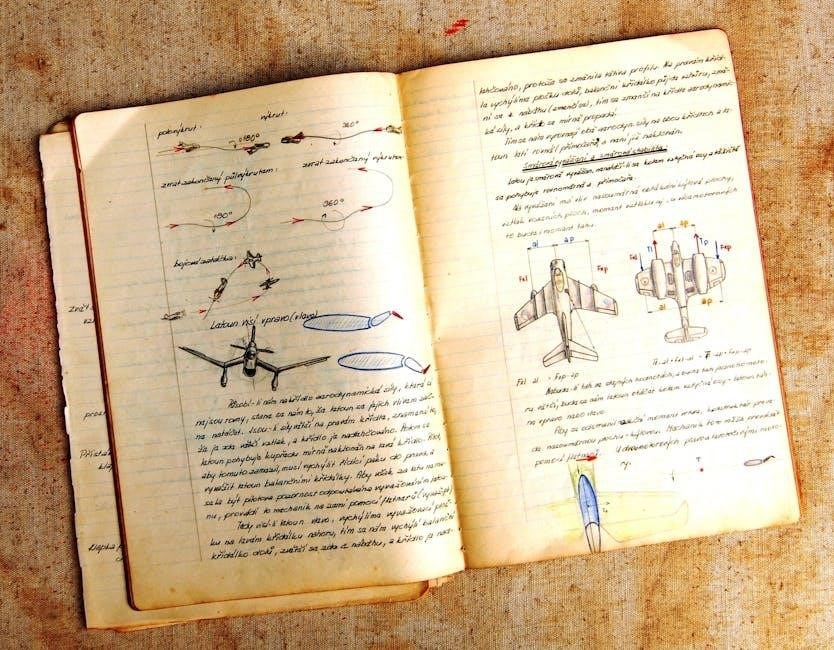The Millermatic 252 manual provides essential guidance for safe and effective operation of the welding system․ It covers installation, maintenance, and troubleshooting, ensuring optimal performance for MIG and FCAW welding processes while maximizing equipment lifespan․
Overview of the Millermatic 252 Welding System
The Millermatic 252 is a versatile MIG (GMAW) and Flux-Cored (FCAW) welding system designed for industrial and professional use․ It features advanced controls, including a 12-inch color TFT display, making it easy to adjust settings for optimal weld quality․ The system supports a wide range of welding applications, from thin gauge materials to heavy-duty steel, and is compatible with Spoolmatic guns for improved efficiency․ With its robust design and user-friendly interface, the Millermatic 252 is ideal for welding in various environments, including fabrication shops, automotive repair, and construction sites․ The system also incorporates safety features, such as thermal overload protection and a cooling system, to ensure reliable operation․ Its versatility, combined with Miller’s reputation for durability, makes the Millermatic 252 a popular choice among welders․ Referencing the manual is essential to fully utilize its capabilities and maintain performance․
Importance of the Manual for Safe and Effective Use
The Millermatic 252 manual is crucial for ensuring safe and effective operation of the welding system․ It provides detailed safety precautions, such as proper grounding and ventilation, to prevent accidents and exposure to harmful fumes․ The manual outlines essential maintenance routines and troubleshooting steps, enabling users to identify and resolve common issues quickly․ Additionally, it guides users through installation procedures, including wire spool setup and electrical connections, to ensure the system functions correctly․ By following the manual, users can optimize weld quality and extend the lifespan of the equipment․ The document also highlights California Proposition 65 warnings, emphasizing compliance with safety standards․ Understanding the manual’s contents is vital for operators to harness the full potential of the Millermatic 252 while minimizing risks and ensuring efficient, professional-grade welding performance․

Safety Precautions

The Millermatic 252 manual emphasizes critical safety measures, including proper grounding, ventilation, and personal protective equipment․ It warns against fire hazards, electrical risks, and harmful fumes, ensuring a safe welding environment․
Safety Symbols and Their Meanings
The Millermatic 252 manual uses specific safety symbols to alert users to potential hazards․ The DANGER symbol indicates a situation that could result in death or serious injury if not avoided․ The FIRE or EXPLOSION symbol warns of risks associated with flammable materials or sparks․ The MOVING PARTS symbol cautions users to avoid contact with machinery components that could cause injury․ Additionally, the HIGH-PRESSURE GAS symbol highlights risks related to compressed gas cylinders, which can explode if damaged․ These symbols are accompanied by explanations in the manual to ensure users understand the risks and take appropriate precautions․ Adhering to these warnings is crucial for safe operation and maintenance of the welding system․
General Safety Guidelines for Operation
Following general safety guidelines is crucial for safe operation of the Millermatic 252․ Always wear protective gear, including oil-free leather gloves, safety glasses, and a welding helmet with a shaded lens․ Avoid loose clothing or jewelry that could catch in moving parts․ Ensure the work area is clean, dry, and free from flammable materials․ Keep a fire extinguisher nearby and maintain proper ventilation to avoid inhaling welding fumes․ Never weld on closed containers or near combustible gases․ Disconnect the power source when performing maintenance or when the unit is not in use․ Keep children and unauthorized individuals away from the welding area․ Adhere to all electrical safety precautions to prevent shocks or fires․ Failure to follow these guidelines can result in serious injury or equipment damage․ Always refer to the manual for specific safety instructions tailored to the Millermatic 252․
California Proposition 65 Warnings
The Millermatic 252 manual includes California Proposition 65 warnings to inform users about potential exposure to chemicals known to the State of California to cause cancer, birth defects, or other reproductive harm․ Welding fumes and gases produced by the Millermatic 252 contain such chemicals․ Engine exhaust from gasoline-powered equipment also contains chemicals known to cause cancer, birth defects, or other reproductive harm․ These warnings are provided to comply with Proposition 65, ensuring users are aware of potential risks․ It is essential to follow all safety precautions, including proper ventilation and the use of appropriate personal protective equipment, to minimize exposure․ Users should also review the manual for specific details on these warnings and how to operate the equipment safely․ Miller Electric Mfg․ LLC provides these warnings to help users make informed decisions about their safety and health when using the Millermatic 252 welding system․

Installation Requirements
The Millermatic 252 requires a dedicated branch circuit and proper electrical connections․ Ensure input voltage matches the unit’s rating and follows local codes․ Correct installation prevents electrical hazards and ensures safe, efficient operation․
Step-by-Step Installation Procedure
To ensure proper setup of the Millermatic 252, follow these steps:
- Unpack the unit and inspect for damage․ Locate the serial number on the rating label for future reference․
- Set the gun polarity based on the wire type (DCEP for solid steel, stainless steel, or flux core with gas wires)․
- Install the wire spool, ensuring proper hub tension and alignment with the drive rolls․
- Connect the Spoolmatic gun or other compatible welding guns, routing cables and gas hoses correctly․
- Attach the weld output terminals, ensuring secure connections to avoid voltage drop․
- Connect input power, adhering to the specified voltage and amperage requirements․
- Thread the welding wire through the gun conduit, trimming excess liner for smooth feeding․
- Test the system at low settings to confirm proper operation before full use․

Adhere to these steps to ensure safe and efficient installation of the Millermatic 252 welding system․
Connecting the Spoolmatic Gun and Wire Spool
Connecting the Spoolmatic gun and wire spool to the Millermatic 252 requires careful attention to detail to ensure proper functionality․ Begin by inserting the gun’s trigger plug into the receptacle and tightening the threaded collar securely․ Route the weld cable through the front panel opening and the gas hose along the side panel․ Connect the weld cable to the positive weld output terminal, ensuring it is tightly secured against the copper bar․ For the wire spool, install either a 1 lb or 2 lb spool by aligning it with the hub and adjusting the tension using the compression spring until slight resistance is felt․ Thread the welding wire through the inlet guide, pressure adjustment knob, and drive roll outlet․ Lay the gun cable straight and trim any excess wire liner to prevent feeding issues․ Properly connecting these components ensures smooth wire feeding and consistent welding performance․ Always refer to the manual for specific torque and alignment specifications to avoid damage or malfunction․

Electrical Service and Power Requirements
Proper electrical service and power requirements are critical for the safe and efficient operation of the Millermatic 252․ The welding system must be connected to a dedicated branch circuit sized according to the unit’s rated output and duty cycle․ For a 230 VAC, 1-phase input, the recommended circuit size is based on a 4-volt drop or a current density of at least 300 circular mils per ampere․ Use a NEMA Type 6-50R receptacle for the power connection, ensuring the grounding conductor is properly connected to meet National and Local Electrical Codes․ Always verify the input voltage and amperage ratings on the serial number label to ensure compatibility with your power source․ Failure to follow these guidelines may result in electric shock, fire hazards, or equipment damage․ Consult a licensed electrician if unsure, and ensure all connections comply with safety standards to maintain optimal performance and prevent potential risks․

Operating the Millermatic 252
Operating the Millermatic 252 involves understanding its controls, modes, and parameter settings․ Start by powering up the unit, selecting the appropriate wire feed speed, and adjusting voltage for optimal welding performance․ Always monitor settings during operation to ensure consistent results and address any issues promptly․
Understanding the Controls and Meters
The Millermatic 252 features a user-friendly control panel designed to optimize welding performance․ Key controls include the voltage control, wire speed control, and a voltmeter to monitor voltage levels during operation․ The wire feed speed meter displays the wire feed rate, ensuring accurate settings for different materials and thicknesses․ Additional features like the Tip Saver and automatic timers help preserve contact tips and reduce gas and wire waste․ Understanding these controls is essential for achieving consistent weld quality and maintaining equipment efficiency․ Always refer to the manual for detailed instructions on adjusting settings for specific welding tasks․ Proper use of the controls and meters ensures safe and effective operation, while also extending the lifespan of the welding system․
JOG and RUN-IN Modes of Operation

The Millermatic 252 offers two distinct operational modes: JOG and RUN-IN․ The JOG mode allows for momentary welding activation, ideal for tack welding or precise control in tight spaces․ This mode is activated by a brief pull of the trigger, providing immediate but temporary operation․ The RUN-IN mode, factory-set at 100%, ensures a smooth wire feeding process at startup, preventing wire tangles and maintaining consistent weld quality․ Adjusting the RUN-IN settings is possible by modifying the parameters with the power switch turned off․ These modes enhance operational flexibility and safety, catering to various welding tasks and materials․ Proper use of JOG and RUN-IN modes ensures efficient and precise welding outcomes, while also protecting the equipment from potential damage․ Always refer to the manual for detailed instructions on mode activation and customization to optimize performance for specific applications․

Setting Weld Parameters for Optimal Results
Setting weld parameters on the Millermatic 252 is crucial for achieving high-quality welds․ The manual provides detailed guidance on adjusting voltage, wire feed speed, and polarity to suit different materials and thicknesses․ Voltage control allows for precise arc characteristics, while wire feed speed ensures consistent wire delivery․ Polarity settings, such as DCEP (Direct Current Electrode Positive), are recommended for specific wire types like solid steel or flux core․ The machine features a voltmeter and wire feed speed meter to monitor settings accurately․ Built-in timers, such as the Tip Saver, help protect the equipment by reducing wear on contact tips․ Proper parameter setup ensures minimal spatter, penetration, and bead appearance․ Always refer to the manual’s charts for material-specific recommendations to optimize weld quality and equipment performance․ Adjustments should be made with the power switched off to ensure safety and avoid accidental activation․ Proper parameter configuration is key to achieving professional-grade welds consistently․

Maintenance and Troubleshooting
Regular maintenance ensures the Millermatic 252 operates efficiently․ Tasks include cleaning the wire feeder, inspecting contact tips, and lubricating moving parts․ The manual provides troubleshooting solutions for common issues like faulty wire feeding or inconsistent arcs, helping users address problems without downtime․
Routine Maintenance Tasks
Regular maintenance is crucial for the optimal performance of the Millermatic 252․ Users should clean the wire feeder and gun regularly to prevent debris buildup․ Inspecting and replacing worn contact tips ensures consistent weld quality․ Lubricating moving parts, such as the wire feed mechanism, prevents friction and wear․ Checking the welding cable for damage and ensuring proper connections are essential for safety and efficiency․ The manual recommends scheduling these tasks to maintain productivity and extend the lifespan of the equipment․ Additionally, monitoring the duty cycle and allowing cooldown periods prevents overheating․ Following these routine maintenance tasks ensures the Millermatic 252 operates reliably and delivers consistent welding results․
Troubleshooting Common Issues
Troubleshooting the Millermatic 252 involves identifying and addressing common issues promptly․ Poor weld quality may stem from incorrect voltage or wire feed settings․ Inspecting the wire feed system for blockages or kinks ensures proper wire delivery․ If the machine fails to power on, check the electrical connections and circuit breaker․ For inconsistent arc performance, verify gas flow settings and ensure the torch is clean․ The manual provides detailed diagnostic steps, such as checking for loose connections or damaged components․ Regularly reviewing error codes and referring to the troubleshooting section helps resolve issues efficiently․ Addressing these problems ensures reliable operation and maintains weld quality․ By following the manual’s guidelines, users can quickly identify and fix common issues, minimizing downtime and optimizing productivity․
Final Tips for Maximizing the Lifespan of the Millermatic 252
Regular maintenance is crucial for extending the lifespan of the Millermatic 252․ Ensure all components are clean and free from debris․ Check and replace worn parts promptly․ Proper storage in a dry, cool environment prevents rust and damage․ Always follow the manual’s guidelines for installation and operation to avoid overload and overheating․ Regularly inspect the welding wire and spool for tangles or damage․ Keep the duty cycle within recommended limits to prevent thermal stress․ Schedule periodic professional servicing to address any hidden issues․ By adhering to these tips, users can ensure their Millermatic 252 operates efficiently for years, maintaining peak performance and reliability․


